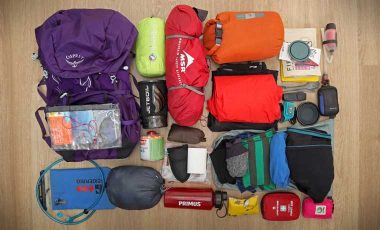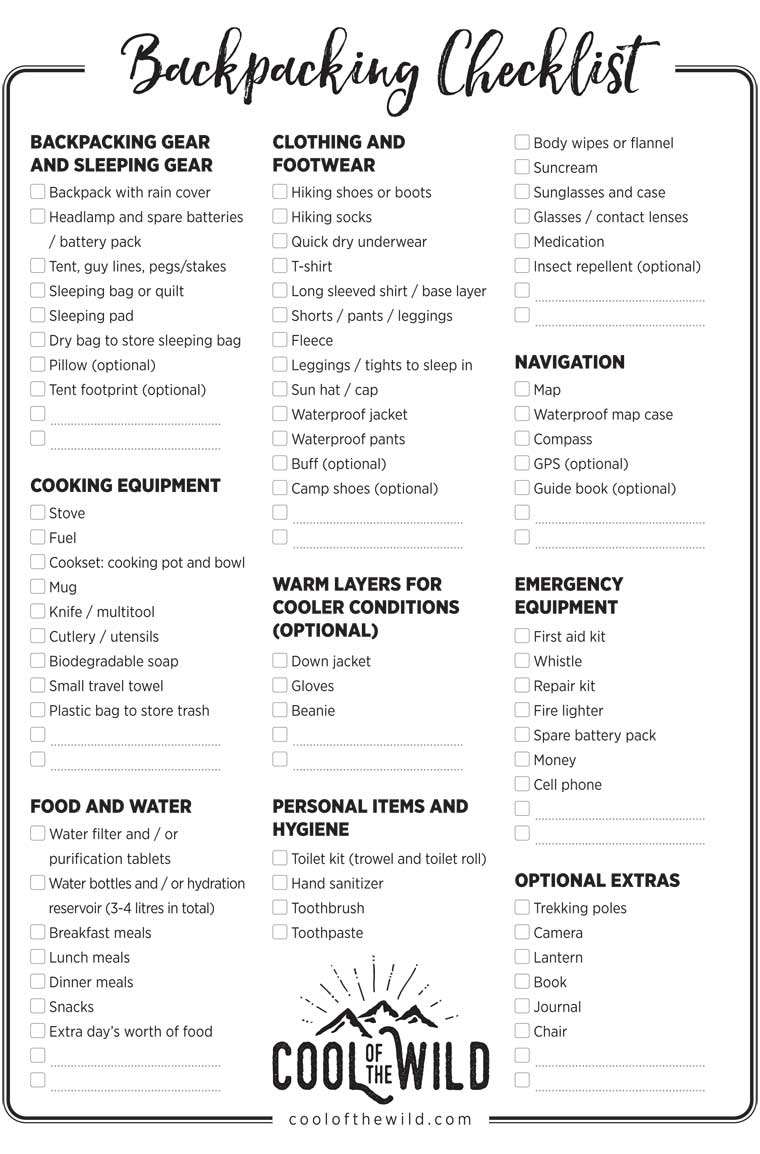For many years I’ve not bothered using a backpacking checklist. I felt that each trip was always so different to the next that no single backpacking packing list would always have me covered. This is mostly affected by the climate or weather conditions, but also by the duration and difficulty of the expedition. And to a degree, this is true. No two trips are ever the same and there’s most certainly things you’ll need on one trip that are just pointless taking on another.
That said, I can’t tell you the number of times I’ve either forgotten to pack something (usually relatively minor). Or worse, had ongoing anxiety that I’ve failed to pack something major once it’s too late to repack. This is where having a backpacking checklist comes in very handy. Even if you know exactly what you need, it takes away that niggling doubt at the back of your mind and reassures you that you’ve nailed it!
If two-wheeled adventuring is more your thing, then you’ll find our bike touring gear checklist and guide more useful.
Another great reason to turn to a backpacking checklist before you head to the hills is if you’re just starting out hiking. There may be a few things on the below hiking trip packing list that you may not have thought of, or even known about! Having a packing list will help guide you in the right direction and highlights the extra gear and clothing that you’ll need to buy, hire or borrow to have the most comfortable and safe trip possible.
- Backpacking checklist for overnight hiking trips
- Backpacking checklist PDF
- Backpacking gear list in detail
Disclaimer: We use affiliate links and may receive a small commission on purchases.
Backpacking checklist for overnight hiking trips
The below list of backpacking essentials is a guide to help you pack right for your trip. There are probably things on the list that you know you won’t need. Likewise, if you’re relatively new to multi-day hiking, you may find that you pack everything on this overnight backpacking list but don’t use some of it. Note what you do and don’t use so that on your next trip you can tailor your backpacking checklist to suit you and your needs.
The below overnight hiking checklist is designed to be used directly on the webpage. Click on the ‘X’ to cross the item off the list (stuff you don’t need to take). Or click on the box to tick the item once you’ve packed it.
Alternatively, we’ve put together a printable backpacking checklist PDF to tick and cross with a good old-fashioned pencil! You can also add your own items to this.
Backpacking gear and sleeping gear
Cooking equipment
Food and water
Clothing and footwear
Warm layers for cooler conditions (optional)
Personal items and hygiene
Navigation
Emergency equipment
Optional extras
Backpacking checklist PDF
If you want to make life as easy for yourself as possible, print out the below backpacking PDF. Handily, it has space to write in extras that aren’t already on the list and you can easily share it with your hiking buddies to guide them through what to take backpacking.
If you are new to overnight hiking trips then taking a printout of the backpacking packing list with you on your hike can be super useful. With all the will in the world, you’re bound to forget to note down extras you didn’t pack if you leave it until after your trip. Do it on your trip and it’ll make packing next time so much easier.
Download Backpacking ChecklistBackpacking gear list in detail
If you’re just starting out in the overnight hiking world then the below information is designed to give you the basics of what to look for when choosing new gear. As you read, you may realise that what you already have is perfectly sufficient, at least for your first few trips. And you may want to consider borrowing or hiring gear until you are ready to invest in the more expensive items. It’s also worth considering buying second hand gear. There’s lots of great stuff out there and you can read how to get hold of it in our guide to used outdoor gear.
Alternatively, you may want to upgrade your existing gear, in which case you may find it helpful to click through to our gear guides and reviews.
Read more details about each category of backpacking gear:
- Backpacking gear and sleeping gear
- Cooking equipment
- Clothing and footwear
- Personal items and hygiene
- Navigation
- Emergency equipment
- Optional extras
Backpacking gear and sleeping gear

Backpack with rain cover
The size backpack you use depends upon the duration of your trip and also how packable the rest of your gear is. Opt for something lightweight and comfortable with good storage options.
Buying tip: Ensure that you get the right size backpack for your body
What I use: Osprey Tempest 50 Backpack
More info: A guide to backpacks for trekking and multi-day hiking
Tent, guy lines, pegs/stakes
A lightweight tent is important for hiking trips, however, it should be stormproof and liveable too. Aim for something under 2.5kg for a 2-person tent. Guy lines and stakes usually come as standard with backpacking tents. Just be sure to check they’re in your tent bag before you set off!
Buying tip: Be sure to LOVE your tent. It’s the most expensive item you’ll buy so try a bunch first to make sure you know what you want.
What I use: MSR Hubba Hubba NX
More info: A guide to backpacking tents
Sleeping bag or quilt
If low weight and warmth is key then opt for a sleeping bag filled with down, which is also super packable. If you’re more likely to be in wet conditions and weight is less important then consider a synthetic sleeping bag.
Buying tip: Sleeping bags come in different sizes. Make sure you choose one that you’ll fit into!
What I use: Big Agnes Sidney SL 25
More info: A guide to sleeping bags for backpacking
Sleeping pad
This is an invaluable piece of backpacking gear that will make or break your sleep quality. Not only does it provide comfort but it also helps to protect you from the cold ground. There are a few different types of sleeping pads available providing varying levels of comfort and warmth.
Buying tip: For 3-season backpacking look for a sleeping pad with an R-value of 1-3. The higher the value the warmer the pad.
What I use: Big Agnes Q-Core SLX
More info: A guide to sleeping pads for backpacking
Dry bag to store sleeping bag
Even if the weather is looking good, I always pack my sleeping bag inside a dry bag. As well as protecting it from the weather, it also protects it from accidents or water bottle leaks inside your backpack. Plus, it makes compartmentalising your gear easier.
Buying tip: A haul handle is useful to drag the dry bag out of your pack more easily.
What I use: Exped Clear Sight Dry Bag
More info: A guide to dry bags
Headlamp and spare batteries
A headlamp is one of those backpacking essentials that is very easy to forget. As well as shedding light on your post-sunset activities at camp, a headlamp is also a must for emergency situations. It’s also a useless item if you don’t have spare batteries or a battery pack to charge it up when needed.
Buying tip: A red light setting is super useful. It uses less battery power and prevents you from dazzling your camping buddies.
What I use: Biolite Headlamp 200
More info: A guide to headlamps for camping and outdoor use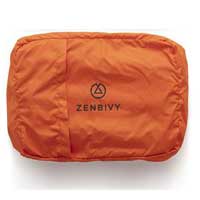
Pillow (optional)
This optional item will turn into a backpacking essential for some people! Others, however, sleep perfectly soundly snuggled up on spare clothing or a down jacket. A night or two without a pillow will soon help you make the decision!
Buying tip: If you hate the idea of an inflatable pillow then opt for a hybrid camping pillow that combines foam with air.
What I use: Zenbivy Light Camp Pillow
More info: A guide to camping pillows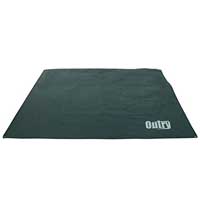
Tent footprint (optional)
Also known as a ground sheet, tent footprints are designed to protect the base of your tent. Lightweight backpacking tents tend to have very thin built-in groundsheets that, depending on the type of ground you are camping on, need a little extra protection.
Buying tip: You can get tent specific footprints. However, generic footprints work just fine providing they are the right size. And they’re often much cheaper.
What I use: Outry Waterproof Tarp
Cooking equipment

Stove and fuel
There are various options of stoves to choose for backpacking. The most common is a gas canister stove which is lightweight, easy to use and packs down very small.
Buying tip: Ensure you have enough fuel for your intended cooking plan. And don’t forget to allow for altitude and the cold, which both use up more gas than usual.
What I use: MSR Pocket Rocket 2
More info: A guide to lightweight stoves for backpacking
Cookware
Depending on your cooking preferences, cookware can range from single pots – intended for cooking and eating out of, to full mess kits with bowls, cutlery and a couple of pots and pans. If you’re only cooking simple meals then keep your cookware set simple and if your stove and fuel fit inside it, then all the better!
Buying tip: Consider a more substantial cookware set with a variety of options that you can then pick and choose from to suit your trip and party size.
What I use: Sea to Summit X-Set 32
More info: A guide to cookware for camping and backpacking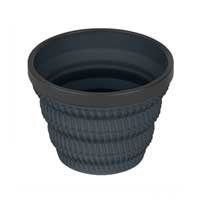
Mug
If the cooking set you choose doesn’t come with a mug then you may want to consider bringing one. There are many options available, from insulated to collapsible. The lightweight options tend not to retain heat that well.
Buying tip: A mug with a handle is useful for clipping it to the outside of your pack, however, they’re not so packable if you want to store it inside your pack.
What I use: Sea to Summit Cool Grip X-Tumbler
More info: A guide to mugs for camping and backpacking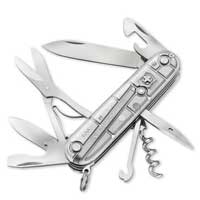
Knife / multitool
A good knife is a backpacking essential that can also be a lifeline in emergencies. However, for something truly versatile and practical, a multi-tool will come in more handy and will have endless uses for more than just preparing food.
Buying tip: Opt for a folding knife, for packability, with a lockable blade for safety, if possible.
What I use: Victorinox Climber Pocket Knife
More info: A guide to knives for camping and backpacking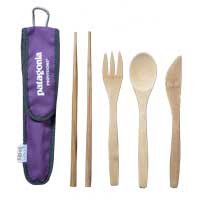
Cutlery / utensils
Some backpackers need little more than a good old Spork for their backpacking cuisine. These are just fine if you are eating boil in the bag meals. However, if you are preparing more than spoonable food you may want to consider a set of utensils that you can cook and eat with.
Buying tip: Folding cutlery is great for packability. But metal utensils aren’t great for food prep and cooking as they can damage non-stick pots.
What I use: Patagonia Bamboo Utensils Set
More info: A guide to camping and backpacking utensils
Biodegradable soap and travel towel
A small bottle of biodegradable soap is not only great for washing your dishes, but it also doubles as a body wash for you too! Combo it with a small, quick-drying travel towel and cleaning up your dishes is a breeze.
Buying tip: Opt for an organic liquid soap made with natural ingredients, and a towel that packs down super small.
What I use: Sea to Summit Airlite Towel
More info: A guide to towels for backpacking and camping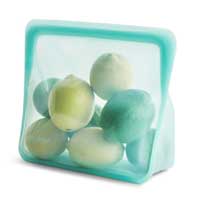
Zip lock bag to store trash
A sealable bag is ideal to prevent moisture and odours from getting into the rest of your stuff. A simple zip lock bag works well. But if you want to use something more substantial then consider a small dry bag or a reusable silicone bag.
Food and water

Water filter and / or purification tablets
There are loads of filtration and purification systems available for camping and backpacking. It’s important to understand the availability of water where you predominantly hike and whether you can top up as you go or if you’ll need to fill larger bottles to last for longer.
Buying tip: Consider whether you’re filtering for just you or for your whole party. You’ll also need to understand if there are specific nasties that you’ll need to filter out in the area you’ll be hiking in (heavy metals, pesticides, viruses etc).
What I use: MSR Trailshot Pocket-Sized Water Filter or Grayl Ultralight Purifier Bottle
More info: A guide to water filters for backpacking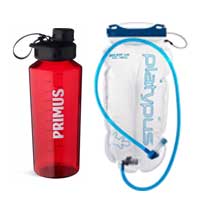
Water bottles and / or hydration reservoir (3-4 litres in total)
You’ll need to carry at least 3 litres of water per day, or more in hotter climates. Don’t forget to consider your cooking needs, and also whether you can collect and filter water on the trail.
Buying tip: Consider a combination of bottles and a reservoir. Bottles are great for cooking and refiling whilst reservoirs hold higher volumes and are easier to drink from as you hike.
What I use: Platypus Big Zip Reservoir and Primus Trailbottle Tritan
More info: A guide to hydration bladders and a guide to hiking water bottles
Food
The food you choose to eat on the trail is highly dependent on your personal preferences. However, you’ll need to ensure that you consume enough calories to replace what you have burned, at the very least. Ensure that the food you plan to cook is quick and easy so as not to use up too much gas or fuel.
Buying tip: If you can spare the weight and space, a yummy treat can change everything at the end of a long day on the trail.
What I eat: I tend to compile my own meals or use Right On Trek meals if I need something quick and easy.
More info: A guide to backpacking food
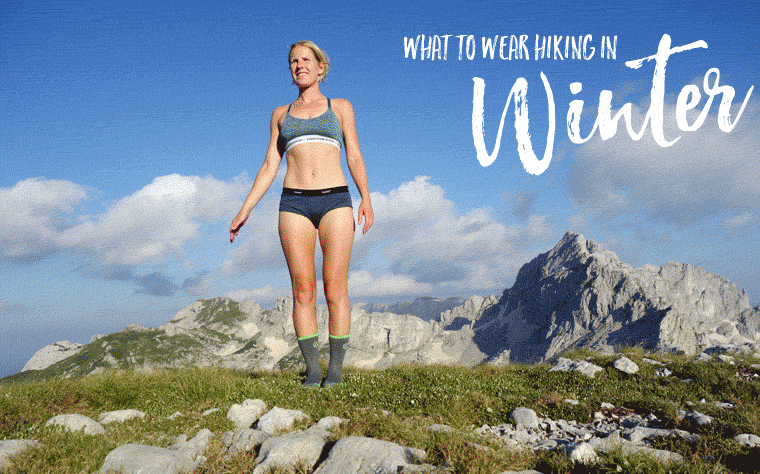
Clothing and footwear
The more you go backpacking, the easier it will be to get your clothing and layering systems right. And of course, you’ll constantly need to adjust what you wear and pack depending on the location, trip duration and conditions.
For more information about what clothing to pack for backpacking, read this article on hiking clothes.
But before you invest everything into getting your hiking clothing right, ensure you have happy feet. Comfortable, durable and protective hiking footwear should be your top priority. They’ll make your time on the trial so much more enjoyable than if you have substandard shoes or boots on. They’ll also help to keep you safe and prevent injury.
First up, decide on which style of hiking footwear is for you. For guidance on this, read our hiking boots vs shoes article.
Once you’ve figured that one out, you’ll need to try a bunch of shoes or boots on to find a pair that works for your feet.
What I wear: Scarpa SL Active Hiking Boots
More info: A guide to hiking boots for women, a guide to hiking boots for men, a guide to lightweight hiking shoes
Personal items and hygiene
Like clothing, your personal hygiene needs are very specific to you. Some folk carry the bare minimum and go to great lengths to save weight; sawn off toothbrushes and all! Whether you take a full wash bag full of stuff or go feral for a few days is entirely your choice.
That said, the one thing that needs careful consideration is dealing with bathroom stops in the wilderness. To help you manage this, you’ll need a trowel, toilet roll stored in a waterproof bag, a sealable bag to store used toilet paper in and hand sanitiser.
My toilet kit looks like this:
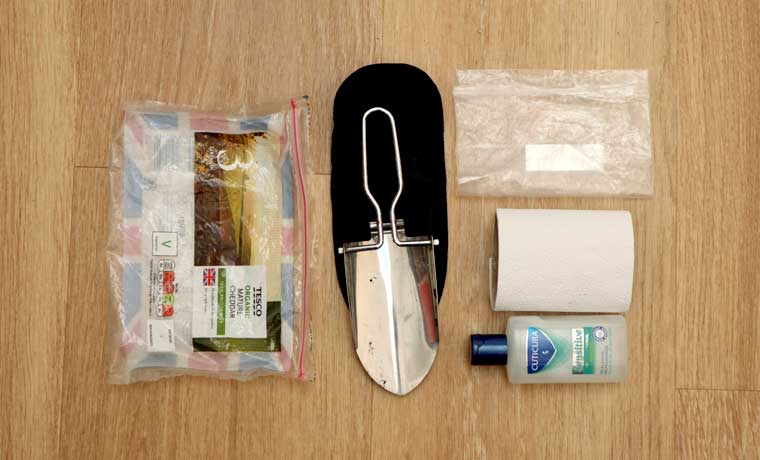
It’s nothing fancy. As you can see I’ve put a cleaned out, resealable cheese packets to good use!
More info: A guide to camping hygiene
Navigation
When it comes to navigation, you’ll need to pack a compass and an appropriate map at the very least. Many hikers also use GPS devices for extra peace of mind or when navigating in remote or challenging areas. Whichever you choose, ensure that you know how to use them! GPS devices need charging up and maps should ideally be stored in a waterproof case.
Emergency equipment
Check and double check your emergency equipment before you pack it. First aid kits should be refilled and updated, if needed, and repair kits should have all the necessary components to patch up, tie together or sew up your gear, should it fail.
As you become more experienced, your emergency items and repair kits will no doubt change as you discover what you do and don’t need. However, if in doubt, it’s always better to pack it and not need it than to not pack it and need it.
Optional extras
As with many of the items on this backpacking packing list, the extras you pack will alter as your needs and wants evolve the more trips you take. Trekking poles, for example, are a backpacking essential for many hikers. And some hikers hate them! Try them out and learn how to use them to see if they’re for you. And read our article on the benefits of trekking poles to see what you might be missing out on.
Sometimes, packing extras, like a camera, book or journal, may seem like a bit of a luxury. But if they add enjoyment to your trip then there’s little point not taking them. On the flip-side, you may already be at capacity when it comes to your weight and carrying limit. A few days without extras may not be a negative and may push you into being more present and engaged with your surroundings.
The above backpacking checklist is designed as a guide to ensure you don’t forget to pack the essentials. As mentioned, it will evolve over time and will also be slightly different for each trip. Whatever you choose to pack, understanding the basics of what to take backpacking will help this evolution process and set you on the right track to being fully prepared for time in the wilderness.
Happy hiking, happy backpackers!


